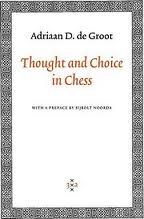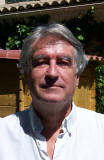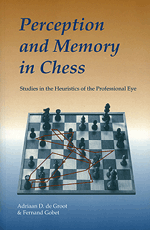
Adriaan D. de Groot (1914-2006), hoogleraar in de psychologie, is bekend om zijn proefschrift Het denken van den schaker, als ontwerper van de CITO-toets en als auteur van Methodologie. Hij speelde mee in NK’s, zat in het Nederlands Olympiadeteam en Ben Grapperhaus zei: ‘Adriaan overwoog heel serieus om beroepsschaker te worden.’
Dat deed De Groot uiteindelijk niet. Hij schreef wel een psycho-analytische studie naar Sint Nicolaas en naar verluidt was de hard-methodologische De Groot het meest trots op deze ‘zachte’ studie.
In de Middeleeuwen was Sinterklaas niet de man die kinderen cadeautjes bracht. Hij was patroonheilige van de eenzame zielen en van de kinderloze koppels. Van de liefde.
Het navolgende Engelstalige stuk gaat in op De Groot en aan het einde ook op zijn interpretatie van Sinterklaas.
‘I wanted to show that chess was a game that differed quite a bit from people’s perception of it. I came to understand through my research that playing chess involves many skills, including intuition and memory. It turns out that calculation is rather unimportant. You always use intuition, i.e. every time you decide to make one move in preference to another. That know-how – knowledge and experience – is an awfully important part of chess.’
These are the words of chess player and psychologist Adriaan de Groot. In the late 1930s, he was among the top ten players in the Netherlands and seriously considered turning professional. He came fourth in the 1938 Dutch Championship and represented his country in the Olympiads at Stockholm 1937 (where he scored 9/15 as reserve) and Buenos Aires 1939 (9½/17 on board 3). During that time he was studying mathematics and psychology at the University of Amsterdam.
De Groot conceived his great research project after Euwe had introduced him to the world’s top players at the 1938 AVRO tournament. He resolved to analyse the thought processes of chess players. The world’s elite like Alekhine, Euwe, Fine, Flohr, Keres, Tartakower, the Dutch players Prins and van Scheltinga, Amsterdam amateurs and the female chess players Roodzant and Heemskerk all agreed to take part.
De Groot showed them various chess positions and recorded their thoughts. He found that the strong players sought the correct strategy immediately whereas the amateurs wasted a lot of time on faulty plans and calculations. Later experiments to record eye movements would confirm these results (Het oog van de meester [The eye of the master] by Riekent Jongman, 1968).
De Groot’s best-known chess experiment was to ask his subjects to consider a position for between two and 15seconds and then to memorise it. Strong chess players proved the most adept at reconstructing perfectly ‘logical positions’, whereas even lesser players with a good memory tended to fail. The chess masters saw the pieces not as single objects but as patterns, configurations of pieces, plans and series of moves. De Groot’s explanation for this phenomenon was that the masters preferred to use their intuition based on experience whereas weaker players relied more on calculation. Chess is therefore more a game of ‘looking and seeing’ than calculating. Obvious conclusions bordering on the trite, you might think, but they were novel at the time.
De Groot’s experiment was one of the first systematic pieces of psychological research into a thought process. In 1946, he became a Ph.D. cum laude in mathematics and physics as a result of his thesis entitled Het denken van den schaker: een experimenteel-psychologische studie (The thought of the chess player: an experimental-psychological study).
De Groot is best known as a mathematical psychologist, the author of Methodologie (1961) and creator of the Cito test (an ‘Eleven Plus’ multiple-choice exam to select children for secondary school. Psychologist Jaap van Ginneken writes of De Groot:
‘I was sceptical about his influence as a mathematician on psychology of the time; according to the “positivistic” principle of “measuring is knowing is predicting is controlling”. He lost faith in this [principle] later in life. In the 1960s I applied his theories to the causes of riots in my MA thesis. He was far more enthusiastic about them than I was. The conclusion was that nobody would turn out to protest when it started raining. My book Breinbevingen (Brain Quakes) from 1999 only partly agrees with his Methodologie. Very different processes play a central role in mass psychology. He was a very kind and amiable man who meant well. To this day the most influential Dutch psychologist.’
And the controversial philosopher C.W. Rietdijk https://renzoverwer.wordpress.com/2013/10/12/de-strijd-van-cw-rietdijk/, whose works include Wetenschap als bevrijding (Science as Liberation, 1997), recalls:
‘I went to see him once; we had a pleasant conversation. But he and I applied scientific reasoning to quite different fields. That is why our paths rarely crossed. Another difference between him and me is that he did not necessarily arrive at ‘shocking conclusions’. But he radiated a kind of integrity; and that is what drew him to science, or perhaps it was the other way around.’
But de Groot was more than a numbers man. For several years he worked as a psychologist for the Dutch electronics firm Philips and he campaigned vigorously against the bad psychological science of the 1950s which was dominated by graphology and the Rorsach test.
Sex and Santa
‘One needs to have conquered the fear of one’s own sexuality to grasp the connection between St. Nicholas and life education, and to appreciate this connection.’
So wrote de Groot in his most personal book Sinterklaas als Patroonheilige (St. Nicholas as Patron Saint, 1949). He and his second wife, Elsa van Embden, observed that many of the stories about St. Nicholas (the Germanic incarnation of Santa Claus) their family enjoyed contained Freudian symbols of phallicism and fertility:
• the roof-surfing man on horseback
• the servant (‘Black Peter’) with his birch rod and sack
• Peter climbing down the chimney to empty his sack of sweets into shoes left at the fireside by expectant children.
De Groot saw a strong link between the St. Nicholas legend and courting, marriage, fertility, pregnancy, birth and family life.
In the Middle Ages St. Nicholas was the patron saint of lonely hearts – a matchmaking Cupid. He was also the saint of childbirth and took pity on childless couples. At the sound of children’s voices he’d offer sweets and gifts. De Groot contended that St. Nicholas is an icon of love in all its forms: ‘sexual, family, social and religious’. He also believed that Yuletide tales influence the sexual development of children:
‘Is that not one of the central difficulties in a child’s development – adapting the sexual needs of the individual to social norms? We … parents, educators, authorities, clergymen – are a bit embarrassed about it and treat the subject clumsily.’
The book got mixed reviews when it was first published in the Netherlands but many years later the English translation caused quite a stir.
De Groot anticipated the sharpening of Santa’s commercial claws:
‘In November and December, golden months for sales, the department stores in particular take full advantage of the character of St. Nicholas. Soon St. Nicholas will enter the living room of every well-to-do household through the TV screen; then he will no longer need to arrive in person at all.’
De Groot became well known for interesting and provocative observations. He agitated for more research into talent identification and in the process upset supporters of equal opportunity: ‘When in the unfortunately all-too-distant future society will bother to interest itself in that small group of exceptionally gifted people who are the actual bearers and makers of culture, then the issue of identifying talent at an early age will demand attention.’ It’s hardly surprising that de Groot often clashed with the democratic movement.
He worked at the University of Amsterdam from 1948 to 1985 before retiring to the North Sea island of Schiermonnikoog. There he could think and write in quiet isolation.
Through his lectures, books and personal tuition De Groot equipped generations of psychologists and behavioural scientists with the tools of their trade. His students included legal psychologist Hans Crombach and computer scientist Jaap den Herik.
De Groot stopped playing competitive chess in 1948, but he did not desert the game entirely. ‘It is a passion for life,’ he said. He continued to play informally with Prins, Cortlever, Barendregt and others. He remained active in his profession well into
old age and co-published with psychologist and IM Fernand Gobet a sequel to his thesis entitled Perception and Memory in Chess(Van Gorcum, 1996). Gobet wrote a fine tribute to his mentor entitled ‘Adriaan de Groot: Marriage of Two Passions’.
Ben Grapperhaus, an old chess friend of de Groot’s, puts it as follows:
‘It is typical of Adriaan that he always wanted to keep on working. He often talked about what he wanted to do next. He preferred not to look back, but ahead; quite remarkable for an old man. He sent me a CD of his improvisations at the piano: Adriaan speelt, recorded by his children on his 90th birthday. That CD is quite good! Whatever Adriaan did, he did well, and with passion!’
| Adriaan de Groot | 1937.08.02 |
| Stefano Rosselli del Turco | Stockholm SWE |
| 1-0 | 7th olm final (4) |
1. d4 d5 2. c4 e6 3. Nc3 Nf6 4. Bg5 Nbd7 5. e3 c66. cd5 ed5 7. Bd3 Be7 8. Qc2 O-O 9. g4 Re810. Bf6 Nf6 11. g5 Ne4 12. Ne4 de4 13. Be4 Bb414. Kf1 Qg5 15. Bh7 Kh8 16. Be4 f5 17. Bg2 f418. e4 b6 19. Nf3 Ba6 20. Kg1 Qh5 21. h4 Rad822. a3 Bf8 23. Re1 c5 24. d5 Bc8 25. Qc3 Bg426. Ng5 c4 27. Bf3 Rd6 28. Bg4 Qg4 29. Kf1 Rf630. Qf3 Qf3 31. Nf3 Bc5 32. Rg1 b5 33. e5 Ra634. d6 c3 35. bc3 Ra3 36. d7 Rd8 37. e6 Ra238. Re2 Ra1 39. Kg2 Rg1 40. Kg1 Be7 41. Ne5
Dit artikel verscheen eerder in het tijdschrift KingPin, twee jaar na De Groots dood. Vertaling: Kaarlo Schepel.
Ontdek meer van Renzo Verwer, blogger/auteur
Abonneer je om de nieuwste berichten in je inbox te ontvangen.




